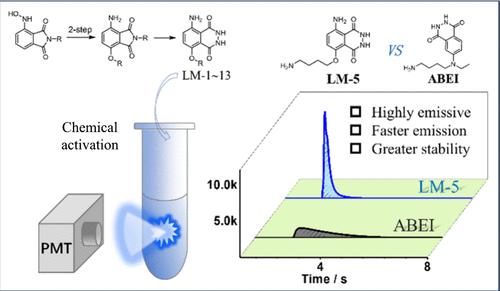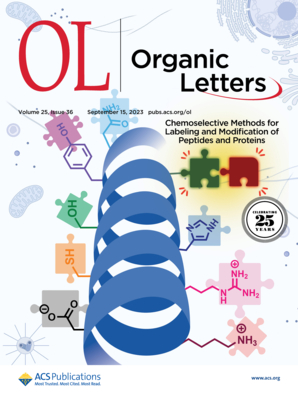用于直接化学发光检测的高发射发光团
IF 5
1区 化学
Q1 CHEMISTRY, ORGANIC
引用次数: 0
摘要
直接化学发光(CL)检测需要一个合适的发光团通过非酶激活发光。本文合成了一类具有强CL发光的3-氨基苯并肼类发光团(LM-1-LM-13)。研究了一种典型的类似物LM-5,与广泛使用的发光团N-(4-氨基丁基)-N-乙基异亮醇(ABEI)相比,它具有显著改善的CL性能和增强的储存稳定性。基于磁珠的CL检测结果表明,LM-5在生物传感应用中具有成为下一代发光团的巨大潜力。本文章由计算机程序翻译,如有差异,请以英文原文为准。

Highly Emissive Luminophores for Direct Chemiluminescence Detection
Direct chemiluminescence (CL) detection requires a proper luminophore to emit light through nonenzymatic activation. Herein, we synthesized a new class of 3-aminophthalhydrazide-type luminophores (LM-1–LM-13) with intensive CL emission. A typical analogue LM-5 was studied in detail, which exhibits greatly improved CL properties and enhanced storage stability compared to the widely used luminophore N-(4-aminobutyl)-N-ethylisoluminol (ABEI). The result of magnetic bead-based CL detection reveals that LM-5 holds great potential to become a next-generation luminophore in biosensing applications.
求助全文
通过发布文献求助,成功后即可免费获取论文全文。
去求助
来源期刊

Organic Letters
化学-有机化学
CiteScore
9.30
自引率
11.50%
发文量
1607
审稿时长
1.5 months
期刊介绍:
Organic Letters invites original reports of fundamental research in all branches of the theory and practice of organic, physical organic, organometallic,medicinal, and bioorganic chemistry. Organic Letters provides rapid disclosure of the key elements of significant studies that are of interest to a large portion of the organic community. In selecting manuscripts for publication, the Editors place emphasis on the originality, quality and wide interest of the work. Authors should provide enough background information to place the new disclosure in context and to justify the rapid publication format. Back-to-back Letters will be considered. Full details should be reserved for an Article, which should appear in due course.
 求助内容:
求助内容: 应助结果提醒方式:
应助结果提醒方式:


